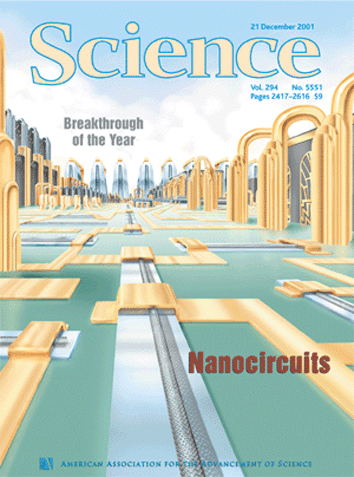NB: The investigation described in this article has now been completed and a number of publications by J Hendrik Schön and co-authors have been retracted as a result. More details about the investigation can be found at http://www.lucent.com/press/0902/020925.bla.html.
Further information can be found at http://physicsweb.org/article/news/6/9/15

Most physicists will be hoping that there is an innocent or logical explanation for the remarkable similarities between the graphs containing the results of quite different experiments on the electronic properties of organic materials in papers published by Jan Hendrik Schön of Bell Laboratories and co-workers over the past two years. If suspicions of data fabrication are confirmed, however, it will be a devastating blow to one of the world’s leading research labs and the careers of those involved. The reputations of leading journals, the burgeoning field of single-molecule nanoelectronics and the physics community as a whole will also suffer. Bell Labs has done all it realistically can at this time by setting up a heavyweight panel to investigate the similarities (see Molecular electronics claims called into question and p5, print version).
Since early 2000 Schön and co-workers have dazzled the physics community with a breathtaking series of results on the electronic and optical properties of a variety of organic materials and molecules. The list seems endless: organic photovoltaic diodes and field effect transistors made of pentacene, a superconducting field effect switch based on carbon-60, observation of the fractional quantum Hall effect in pentacene and tetracene, a solid-state injection laser made of tetracene, and superconductivity in a variety of these molecules. In late 2000 they reported superconductivity in hole-doped carbon-60 at a temperature of 117 K (see Buckyball scores high-temperature goal and Physics World January 2001 p9, print version).
This remarkable programme of research culminated late last year when the researchers reported that they had made a single-molecule transistor. This was one of five or so key papers published by groups around the world that led Science to declare that nanocircuits were the “breakthrough of the year”.
Few groups have been able to reproduce their work but that was taken as evidence of the quality of the samples prepared by Christian Kloc, Schön’s experimental ingenuity and the experience of Bertram Batlogg, one of the world’s most eminent condensed-matter physicists (who recently moved from Bell Labs to the ETH Zurich). But it has now come to light that several graphs showing data from different experiments appear to be identical – right down to the noise in the signal. Just before the storm broke, Schön submitted a correction to Science – he had accidentally sent the wrong graph to the journal for the paper on the single-molecule transistor. However, there are close similarities between figures in five other papers. Further accidents or experimental artefacts have been mooted as explanations for the other similarities, but Schön and Bell Labs are not saying anything until the panel chaired by Malcolm Beasley of Stanford University reports its findings.
The volume of Schön’s work in recent years has been staggering – he has published more than 60 papers since January 2000. It is possible that the occasional figure went astray, but this would seem to have happened too often for this to be the explanation. Unless some other remarkable, but plausible, co-incidence or explanation is forthcoming, the consequences for the physics community will be tragic.
Science fiction: the ultimate factoid
The Science & Engineering Indicators published by the National Science Foundation (NSF) in the US is an impressive document that contains a wealth of information on a vast range of topics (www.nsf.gov/sbe/srs/seind02/start.htm). However, it is a short section on “the interest in science fiction” that catches the lazy eye. According to a recent NSF survey almost equal percentages of men (31%) and women (28%) read science-fiction books or magazines, but the Sci Fi television channel is watched by more men (55%) than women (45%). Readers who are not fans of science fiction will be relieved to learn that “there does not seem to be a relationship between level of education and watching Star Trek“.



